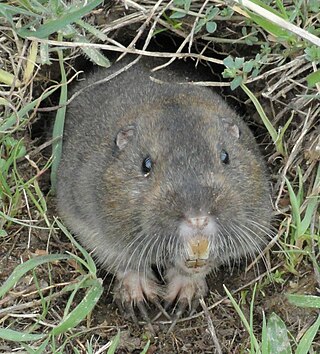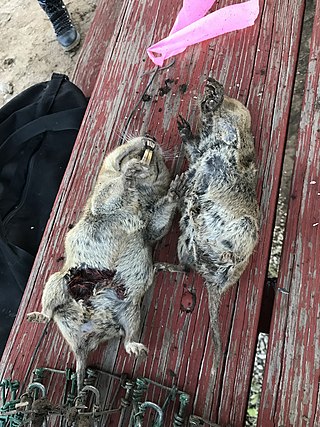
Pocket gophers, commonly referred to simply as gophers, are burrowing rodents of the family Geomyidae. The roughly 41 species are all endemic to North and Central America. They are commonly known for their extensive tunneling activities and their ability to destroy farms and gardens.

The yellow-faced pocket gopher is a species of pocket gopher that is native to shortgrass prairies in the south-western United States and northern Mexico. It is the species that lives north of the Southern Coahuila Filter-Barrier (SCFB). Among the different species, the yellow-faced pocket gopher has a small to medium-sized skull. The fossil of this genus was recorded from the pre-Pleistocene Benson Beds of Arizona.

The desert pocket gopher is a species of rodent in the family Geomyidae. It is found in the state of Chihuahua in Mexico and in Texas and New Mexico in the United States.
The Chiriqui pocket gopher is a species of rodent in the family Geomyidae. It is found in Costa Rica and Panama. Some authors classify it in the genus Orthogeomys, but recent research has allowed this and its related species to be classified in the genus Heterogeomys.
Heterogeomys is a genus of rodent in the family Geomyidae, found in Mexico, Central America and Colombia. Heterogeomys are a small genus of rodents commonly known as pocket gophers, though the term applies to all genera within the family Geomyidae. The name pocket gopher was earned for this family because of their fur lined cheek pouches that can be used for carrying food. These pouches can also be turned inside out. Species of Heterogeomys are regarded as pests, one of less than 5% of rodent species classified as pests, and the history of man's attempts to control their populations reaches back into Mayan times. Despite some efforts to the contrary, populations of Heterogeomys seem to be on a general upwards trend. Furthermore, all of the species of Heterogeomys are considered to be of Least Concern in the World Status Key.
Cherrie's pocket gopher is a species of rodent in the family Geomyidae. It is found in Honduras, Nicaragua, and Costa Rica. It is threatened by habitat loss. Some authors classify it in the genus Orthogeomys, but recent research has allowed this and its related species to be classified in the genus Heterogeomys.
The Darien pocket gopher is a species of rodent in the family Geomyidae. It is occurs in Panama and Colombia. Some authors classify it in the genus Orthogeomys, but recent research has allowed this and its related species to be classified in the genus Heterogeomys.
The giant pocket gopher, also known as the Oaxacan pocket gopher, is a species of rodent in the family Geomyidae. It is found in Mexico, Guatemala, El Salvador and Honduras. It is the type species of the genus Orthogeomys; some zoologists also include in this genus species that have recently been placed in Heterogeomys.
The hispid pocket gopher is a species of rodent in the family Geomyidae. It is found in Mexico, Belize, Guatemala, and Honduras. Some authors classify it in the genus Orthogeomys, but recent research has allowed this and its related species to be classified in the genus Heterogeomys.
The big pocket gopher is a species of rodent in the family Geomyidae. It is endemic to Veracruz state in eastern Mexico. It has only been found on the southeastern slopes of Pico de Orizaba, at elevations of 1,300 metres (4,300 ft).
Underwood's pocket gopher is a species of rodent in the family Geomyidae. It is endemic to Costa Rica. Some authors classify it in the genus Orthogeomys, but recent research has allowed this and its related species to be classified in the genus Heterogeomys.

Merriam's pocket gopher is a species of rodent in the family Geomyidae. It is endemic to Mexico, where it is found in the area of the Valley of Mexico and the Valley of Toluca at elevations from 1800 to 4000 m. Its favored habitats are the Zacatonal grassland and temperate pine-oak woodlands, as well as farmland and rangeland. Its karyotype has 2n = 36 and FN = 68.
The Michoacan pocket gopher is a species of rodent in the family Geomyidae. It is monotypic within the genus Zygogeomys. It is endemic to Mexico where its natural habitat is temperate, high-altitude forests. Its numbers are declining and it is listed by the IUCN as "endangered".

Cratogeomys is a genus of rodent in the family Geomyidae. It was previously considered a subgenus of Pappogeomys. All species are distributed in Mexico and the Southwest United States, with some species being found in both countries.
Goldman's pocket gopher, is a species of rodent in the pocket gopher family. It is distributed throughout northern Mexico. It was formerly considered a subspecies of the yellow-faced pocket gopher. It is named after Edward Alphonso Goldman, who collected the holotype of this species.

The Oriental Basin pocket gopher is a species of pocket gopher which is endemic to Mexico. It was first described in 1895 by Clinton Hart Merriam. It was considered to be a subspecies of Merriam's pocket gopher in the late 20th and early 21st century but has been reinstated as its own species. The IUCN Red List has evaluated it to be of least concern.
The Perote pocket gopher, or Cofre de Perote pocket gopher, is a species of pocket gopher in the family Geomyidae.
The Volcan de Toluca pocket gopher, also known as the flathead pocket gopher, Volcán de Toluca pocket gopher, Nevado de Toluca pocket gopher, or the Toluca Volcano pocket gopher, is a species of pocket gopher that is native to south-central Mexico, at upward elevations of 2500–3500 m. It was described by Clinton Hart Merriam in 1895.






